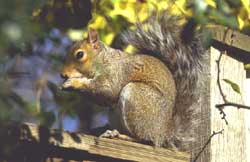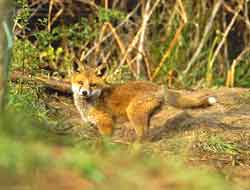 |
 |
Animals Living in and around Linford Wood
Woodland areas such as Linford Wood are a haven for wildlife, many small animals live in and around the wood such as Foxes, Muntjac Deer, Mice, Squirrels, Moles, Hedgehogs, Stoats, and of course Rabbits and many more. To see these animals you have to be very lucky, as they are very clever at hiding, but if you can manage to sit somewhere very quietly for a while and keep your eyes and ears open you will be surprised at just how much you can see going on around you.
The Hedgehog
Hedgehogs like to live mainly on the edge of deciduous woodland as well as in copses and farmland, they live on a mixture of grubs, worms, insects as well as fruits and vegetation which they forage for at night. They hibernate in the winter, and can have a litter of young as late as October although the young born this late in the year are very unlikely to survive the winter.
The Mole
Moles are both nocturnal & diurnal (awake during the day),but molehills are probably the only way you will be able to tell if they are around because the adult mole is very rarely seen above ground, they spend all their time in digging complex tunnels underground, they get rid of the loose soil by pushing it upwards forming the molehills we so often see. People do not often realise that there is a large population of moles in deciduous woodland like Linford Wood as these molehills are often hidden beneath the dense undergrowth.
The Squirrel
The Squirrels like to live in Linford Wood with its abundance of fruit, nuts etc. It has quite an array of foodstuffs to take its pick from, they even eat soil for its mineral content and to provide roughage, their razor sharp teeth are designed for piercing nuts and gnawing the bark off of trees to get at the softer tissue underneath.
Squirrels are very agile moving from tree top to tree top in the blink of an eye using its long tail as a rudder, they can run up and down any tree no matter how smooth the bark with no trouble at all. They are at their most active during the day rising well before sunrise they spend their days feeding and collecting nuts for storage, and it ends well before sunset. Squirrels until recently were thought to hibernate during the winter months, or slept for long periods, We now know that this is not so.

The Fox
The Fox lives in an underground burrow called an Earth, they are most active at night-time when they search for food, their main diet consists of birds, small mammals, voles & rabbits etc sometimes scavenging food from carcasses that they find, they are also seen on the local estates at night picking food from dustbins, so remember not to leave your pet Rabbit or Guinea Pigs out at night just in case they are not there in the morning. In the autumn months they will also feed on fruit that they find.
Although Foxes are mainly spotted on their own, they live in family groups usually consisting of the a Dog (male fox), a Vixen (female) and her cubs, there might also be one or two other non-breeding Vixens living with them from her previous litters.

The Wood Mouse
The Wood Mouse also known as the Field mouse, has a tail almost as long as its body and has soft warm brown fur with sandy or orange brown on its head and back. It only lives for a few months, but if it is artful enough they can survive 18 - 20 months. They eat mostly seeds & nuts but also eat fruit, buds and seedlings, fungi and small snails, caterpillars & insects.
They have to watch out for Owls, Cats, Weasels and a whole host of other animals that would like to make a meal of them. They can anything from 2 to 9 young, but the average number is 5.
The Rabbit
Rabbits were brought to this country in the 12th century from the continent for their meat & skins. Over the last 200 years they have been regarded as agricultural pests, hated by Farmers for eating their crops. Linford Wood has a colony of Rabbits that live mainly around the perimeter of the Wood and can often be seen in the evening on the grassy areas that surround the Wood, they are very social animals and live in large numbers in burrow systems known as warrens. The estate called Conniburrow got its name from the Rabbit (Coney) burrows as the field that the estate was built on was full of them. The female Rabbit can have between three & seven young on average and the breeding season ranges from January through to August. Rabbits staple diet consists of grasses, plants, fruits and tree bark.
The Bat
If you take a look high into the trees in Linford Wood you will see what looks like bird boxes with slit like openings instead of holes, these are Bat boxes and they are there to help our endangered Bat population. In Britain we have several different species of Bat, but all kinds are less common than they were some 30 years ago, this is due mainly to modern day farming & forestry practises, Bats live on insects but with crop spraying and ponds being cleared and filled in these insects are not so readily available.
Bats are not adapted for walking so they have to crawl along very slowly, however they are very adept flyers and can fly long distances very quickly and can catch their prey by swooping and using a form of radar system similar to those used on ships and aircraft. Insect are not so available in the winter months so the Bat hibernates during the coldest spell, a lot of Bats migrate to warmer areas and have been known to end up on oil rigs and ships having being blown off course.
Female Bats breed from their third year, they will have only one baby a year, these babies will be able to fly at 3 weeks and will leave the roost around about 5 weeks old.
There is a lot of old wives tales about Bats and because of this they are not the most popular of our woodland population you will only see them at night and may even mistake them for birds flying out late, we need to protect these harmless little creatures otherwise we are in great danger of losing them for ever.

Wolves and Wild Boar were once roaming wild in Linford Wood
|
 |
 |







